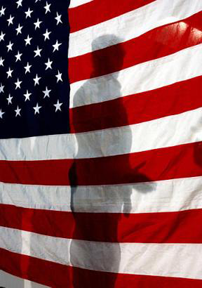 Flag-flying summers are packed with outdoor activities, barbecues and patriotic celebrations. While the American flag is often an important part of these celebrations, many of us have questions about how to properly care for and display it.
Flag-flying summers are packed with outdoor activities, barbecues and patriotic celebrations. While the American flag is often an important part of these celebrations, many of us have questions about how to properly care for and display it.
“Flag etiquette can be confusing,” said Mary “Dubbie” Buckler, Executive Director and National Secretary of the American Legion Auxiliary. “Many Americans want to show patriotism, but do not know the standards of respect and traditions associated with flag flying.”
The American Legion Auxiliary, the world’s largest women’s patriotic organization, helps to advance the mission of The American Legion, the nation’s largest veteran’s service organization, to provide service to veterans, military and their families.
The American Legion has played an important role in establishing the standards of flag etiquette since before the passing of the first national codes in 1923 and has worked diligently to uphold these historical standards. Today, much of flag etiquette can be found in the Flag Code, official national rules regarding the American flag.
“The American flag is meant to be enjoyed and celebrated,” Buckler explained. “The American Legion Auxiliary is passionate about educating the public so they can do so with proper respect for the freedom and sacrifices it represents.”
Buckler shares the following guidelines for using, displaying and caring for the American flag.
Hoisting and Lowering of the Flag:
- The flag should be hoisted briskly and lowered ceremoniously.
- The flag of the United States of America is saluted, or acknowledged by placing a hand over your heart, as it is hoisted and lowered.
- When lowered, the flag should never touch anything beneath it, such as the ground, the floor, water or merchandise.
Manner of Displaying the Flag:
- The Flag Code states it is the universal custom to display the flag only from sunrise to sunset on buildings and on stationary flagstaffs in the open.
- When a patriotic effect is desired, the flag may be displayed twenty-four hours a day if properly illuminated during the hours of darkness.
- The flag should not be displayed on days when the weather is inclement, except when an all-weather flag is displayed.
- The flag should be displayed vertically, whether indoors or out, and suspended so that its folds fall free as though the flag were staffed.
- When displayed in a window of a home or a place of business, the flag should be displayed in the same way; that is, with the union or blue field to the left of the observer in the street.
- Storing and Disposing of the Flag:
- The Flag Code does not require any specific method of storage, however, over time it has become tradition to fold the flag into a triangular shape like that of a three-corner hat, with only the blue union showing.
- When a flag is so worn it is no longer fit to serve as a symbol of our country, it should be destroyed by burning in a dignified manner. The American Legion frequently conducts flag retirement ceremonies, often on Flag Day – June 14.
- Flag etiquette was established to honor and pay tribute to our nation and its history. As such, certain uses of the American flag are considered disrespectful. The flag should never be:
- Displayed with the union down, except as a signal of dire distress in instances of extreme danger to life or property.
- Used as a drapery or for any other decoration.
- Carried flat or horizontally, but always aloft and free.
- Used as a receptacle for receiving, holding, carrying, or delivering anything.
- The flag should never be used as apparel, bedding or drapery.
- Festooned, drawn back, nor up, in folds, but always allowed to fall free.
Standing tall as an emblem of justice, perseverance, valor and honor, the American flag is an intricate part of what makes citizens proud to be American. As summer rays shine again and the flag takes its spotlight, it is important to educate yourself and others to show respect for the deep history and sacrifices this national symbol represents.
Americanism is just one of the programs that our Members take pride in supporting. If you would like to join us please contact your local American Legion Auxiliary or The American Legion Auxiliary Department of Massachusetts regarding eligibility requirements to become a member and contact information regarding a Unit close to you at Telephone: (617) 727-2958 FAX: (617) 727-0741 or E-mail: masslegion-aux@verizon.net
Mary Ellen Morissette
American Legion Auxiliary
Department of Massachusetts
Public Relations Chairman
